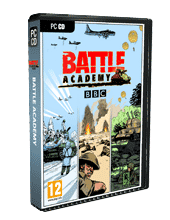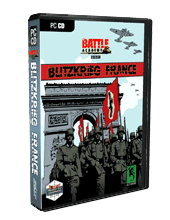Version Reviewed: 1.7.0
What I like: Deep combat, extra objectives for skilled players, abundant content.
Not So Much: Many unit details and combat variables are hidden.
Other stuff you may like: Very moddable. Slitherine play by email system.
The Verdict: 7/10
Introduction
After gorging myself on some lightweight strategy games during the Steam holiday sales (like Swords and Soldiers HD, Might and Magic: Clash of Heros, etc...), I've had a hankering for something more serious in the war genre. Battle Academy is a turn-based tactical WWII strategy game where you can command various infantry, tank, transports, etc across a tile based battlefield. For variety, the game has three campaigns covering North Africa, D-Day and the Ardennes. The following review is based on playing all of the Western Desert Campaign and part of the Battle For Normandy.
After not having too much experience with Matrix Games and Slitherine, my last two titles have come from their catalog. It's just a coincidence - I'm not a shill - I promise!
Getting Started
The first campaign serves as a tutorial mission, walking you through the basics of the game. Pop up messages are used to direct your actions. The mechanics of the game are very simple; click your unit, click the target tile or enemy and, if necessary, click one of the valid commands that pops up. You can control-click to bring up a unit information window and hover over items to get more information. The manual does a pretty good job at introducing the main concepts of the game, but fails to explain many of the underlying mechanics that would be useful while playing. This wouldn't be a problem if the game's UI provided those details, but unfortunately it does not. This doesn't make Battle Academy unplayable by any means, but I prefer to understand how things work beforehand. There are helpful people on the forums to answer questions, but an informative UI would be much better.
Game Play
Each scenario starts with a brief comic-book style introduction, describing the scenario and what to expect. This is followed by a force selection screen which shows your allotted units and where extra units are usually available for purchase to customize the variety of troops you will command in this scenario. There isn't a core group of units to carry over from one scenario to the next. Although in one of the expansions, you can carry units through the campaign. This is neither here nor there though since we are playing the base game right now.
After your forces are selected, the game proceeds to the briefing map which displays an overhead view, accompanied by the objectives. This does add some flavor to the process as you can imagine standing around a table looking over the map with your commanding officers. Victory conditions involve capturing or holding victory locations. Additional achievements are given for tasks such as losing less then a certain number of units, killing at least 'x' enemy units, destroying all enemy units of a certain type, and/or keeping the enemy from advancing beyond a certain point. Some of these achievements have time constraints for added pressure. The optional achievements creates a pretty good system for making the scenarios beatable for less-skilled players, but more challenging for those up to the task. In other games, I'm not fond of having to replay scenarios many times to play the full game. I can choose to replay to get all the achievements (now or later), or I can move on.
I do think it would make more sense to have the force selection screen after seeing the objectives. If you are expecting to encounter a Tiger, you might want to bring extra big guns to take it out.
What are our objectives General?
I Said Jump Soldier!
Now we get to the meat and potatoes. As one would expect, each unit uses an appropriate movement rate and method (such as walking for infantry or tracked for tanks). The movement rate is determined by the amount of action points (AP) the unit has, and it's method determines the cost in AP to enter each type of terrain tile. While a wheeled unit is faster on open roads, it can't enter rough terrain. Before giving the move order you can review the AP cost. Overall the system works, giving each unit an appropriate feel. For additional control, units can be ordered to hunt, which costs more AP, but avoids the movement accuracy penalty applied to shooting and makes the unit harder to spot.
I Can See You, Can You See Me?
Line of sight (LOS) is handled in a typical manner: each unit has a spotting range, and certain terrains, like forests or buildings, interrupt the LOS. Some terrain allows infantry to hide in an effort to ambush oncoming enemies. However, Battle Academy adds an interesting twist: only infantry can spot these units in hiding, and only when adjacent to that tile. This makes infantry very valuable because without their support, your high powered tanks will be reduced to rubble by satchel charge- carrying, bazooka-toting enemies. Specialized scout infantry are available in some scenarios, which have the ability to detect potential ambushes from two tiles away. Also, units on hills don't give away their location to those below until they fire, so take that high ground!
Be Afraid, Very Afraid.
It is hard for a wargame to be taken seriously if there isn't any representation of morale, and Battle Academy executes this well. In the game, as I expect in real life (I've never been a soldier), shooting at a unit decreases its morale - a lot if it actually kills a member of the squad. Even a shot at a tank that deflects off of the armor tests the courage of those inside. Once the morale of a unit drops below the 1st threshold, it is suppressed and loses its ability to initiate an attack. Dropping below the 2nd threshold causes the unit to surrender to any adjacent unit that attacks it. Once things really go to hell, the unit will just rout. Since there doesnt seem to be a limit to the number of times a unit can retreat within a single turn, hunting the enemy down can feel like whack-a-mole (I thank Troy Goodfellow at Flash of Steel for that expression when he was describing Hegemony Philip of Macedon). The retreating never gets out of hand but is sometimes slightly annoying.
Learning From Your Experiences.
As units inflict casualties, their experience increases. Veteran units have increased morale, while Elite units further improve their moral and can obtain new skills - such as a sniper shot that automatically kills one member of an enemy squad. With increased morale, these experienced troops can better withstand the stresses of combat before succumbing to their fear. Experience would have a greater impact if units could be carried from scenario to scenario, but still has a noticeable effect in longer scenarios where there is more time to level up and additional enemies to attack.
Combat!
Combat is the heart of any tactical wargame, and Slitherine's engine doesn't disappoint. The factors are logical and detailed. Units are rated for hard attack (vs armored units), soft attack (vs non-armored units), and armor (defense vs hard attacks). The hard attack is actually based on several factors: (1) minimum & maximum damage rolls (2) the accuracy at different distances (3) the ability to penetrate armor at different distances. Likewise, the soft attack is determined from factors 1 & 2. The armor is rated differently for the front, sides, and rear. Try to avoid the heavy armor in the front of some tanks by attacking from the sides or rear.
Before engaging the enemy, your unit must navigate close enough so they are within their weapon's range. They must survive possible attacks of opportunity by the enemy as they approach. If the target or their allies saved shots from the prior turn, your unit may be in for quite a surprise. All units get at least one attack of opportunity so there is never a free



 Cart (0)
Cart (0)

